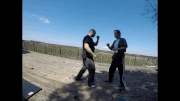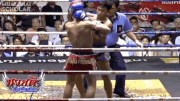drop bear
Sr. Grandmaster
Sit Out.
Last edited:
Follow along with the video below to see how to install our site as a web app on your home screen.
Note: This feature may not be available in some browsers.
Sit Out.
In your clip, he is not chocking on his opponent's neck.Sit Out.

Yep two different things.In your clip, he is not chocking on his opponent's neck.

In your clip, he is not chocking on his opponent's neck.

all you need is a few inches to duck under an arm. Why duck lower than you need to. So you can eat a knee?Not people who are just going to leave there head sticking out and not people who suddenly can't do a Thai clinch because you drop a couple of inches.
The most effective defense is to use your left hand to push on his right elbow joint. As long as his arm can't come back, you will be safe.Correct. Because he is sitting out. The defence is a posture one.

Within reason. There are a couple exceptions to your clip. In Jow Ga we have a kick that follows that swing and you would catch it right in the chest as you duck. The duck would save you from catching it in the face but it will definitely catch you in your chest. You would need to use a different punching technique. We use a similar punch, but the punch being shown here isn't going to flow into a good kick.The most effective defense is to use your left hand to push on his right elbow joint. As long as his arm can't come back, you will be safe.

all you need is a few inches to duck under an arm. Why duck lower than you need to. So you can eat a knee?
The most effective defense is to use your left hand to push on his right elbow joint. As long as his arm can't come back, you will be safe.

The lesson is about controlling the elbow. Do you see a guillotine in that video?So the best defence against a guillotine while doing a duck under is to defend the world worst hook punch?
The lesson is about controlling the elbow. Do you see a guillotine in that video?
Let's switch your position.I think the ultimate lesson is make sure the other guy isnt very good.
Then if he throws a snails pace hook sticking your hand out and trapping his elbow will work.
Let's switch your position.
Are you saying that every time your opponent dodges under your hook punch (or head lock), you can always use elbow to hit on his head (or use reverse head lock on him)?
The only thing that's between your elbow and his head is his hand (or his arm).
If it's actually a hook punch or real attempt at a head lock, there's not really enough time to dramatically alter the direction of the arm's travel with sufficient force to deliver a meaningful elbow blow, in the short time they are passing under it. Fetting to the guillotine in that situation requires a change not only in direction of the arm, but also a change in the structure of the shoulder (arm has to angle completely differently). If the guy hangs out while making the transition, you might be able to deliver a meaningful elbow strike, but that'd be a bad duck-under.Let's switch your position.
Are you saying that every time your opponent dodges under your hook punch (or head lock), you can always use elbow to hit on his head (or use reverse head lock on him)?
The only thing that's between your elbow and his head is his hand (or his arm).
How effective is the MT knee strike? Your thought?
It may be an advantage to have a shorter person in a clinch, but that doesn't necessarily mean it's easier. First you got the get the clinch on. The clinch isn't some kind of unstoppable technique. Like everything else it has points of weaknesses and it has limitations on when it's most effective. If a shorter fighter fights a taller opponent the same way he fights someone of the same size then he will lose. A lot of of what you see as "easier to get." is often the result of that.
In clinch, aIt's a huge advantage, which is why you don't want to make yourself shorter while in the clinch or about to be put into the clinch. Because getting blasted with knees while getting clinched, changes a lot of things.
To receive a knee strike on the chest is bad. But when you hold on your opponent's kneeing leg and then hook his standing leg off the ground, the hard falling for him can be worse. Also, since you hold on one of your opponent's legs, your knee can drop into his groin, that can be even worse.Here's a good example of the MT clinch knee being not easy to just escape or counter when you're getting blasted.
The kind of clinch used affects structure. You can't pick up a leg with the force to knee back if your opponent has pressure applied that keeps you double-weighted (weight even across both feet). You'd also have to get past that structure control to manage something like hooking his standing leg off the ground.To receive a knee strike on the chest is bad. But when you hold on your opponent's kneeing leg and then hook his standing leg off the ground, the hard falling for him can be worse. Also, since you hold on one of your opponent's legs, your knee can drop into his groin, that can be even worse.
It's pretty much like if you don't kill me with your knee strike, I will take you down hard and then drop my knee into your groin. Which one is worse?
The moment that your opponent is down, the moment that the striking game is over, the grappling game will start.
Even if your structure is broken, you still have 2 free hands.The kind of clinch used affects structure. You can't pick up a leg with the force to knee back if your opponent has pressure applied that keeps you double-weighted (weight even across both feet). You'd also have to get past that structure control to manage something like hooking his standing leg off the ground.

